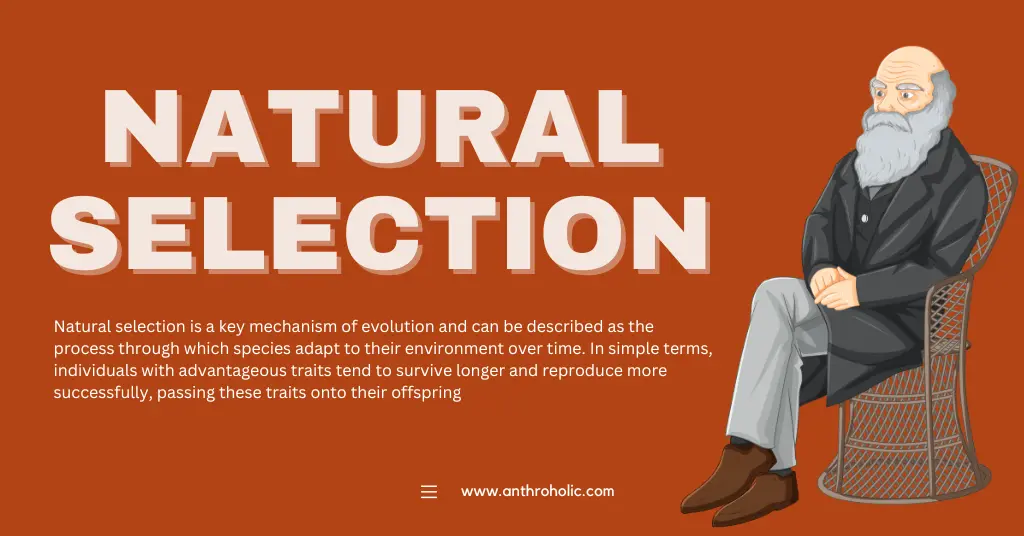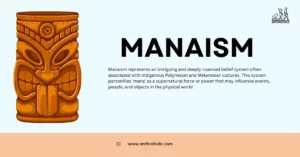AI Answer Evaluation Platform Live Now. Try Free Answer Evaluation Now
Natural Selection
Natural selection is a key mechanism of evolution and can be described as the process through which species adapt to their environment over time. In simple terms, individuals with advantageous traits tend to survive longer and reproduce more successfully, passing these traits onto their offspring [1]. This concept, also referred to as “survival of the fittest,” underlies the notion that species do not evolve randomly but rather in response to the pressures of their environment.

The theory of natural selection was first proposed by Charles Darwin in the mid-19th century. In his groundbreaking book, “On the Origin of Species,” Darwin argued that natural selection was the primary driver of species evolution [2]. Though initially met with controversy, the theory has since become a cornerstone of biological science and has profoundly influenced various disciplines, including anthropology.
The Role of Natural Selection in Anthropology
The role of natural selection in anthropology is multi-faceted, touching on numerous aspects of human biology, behavior, and culture. As a fundamental process of evolution, it provides the framework for anthropologists to explore and understand the complex tapestry of human evolution and diversity.
Biological Anthropology and Human Evolution
Biological anthropology, also known as physical anthropology, studies the biological development of humans and human ancestors. Natural selection is central to this field, aiding in understanding how and why humans evolved particular physical and physiological traits. For example, the evolution of bipedalism – walking upright on two legs – is considered a key adaptation in human evolution that has been extensively studied within the context of natural selection.
Dietary adaptations, like lactose tolerance, is another prime example of natural selection in human populations. The ability to digest lactose beyond infancy developed in populations that domesticated dairy animals, conferring a nutritional advantage and increased survival.
Molecular Anthropology and Genetic Diversity
With advances in genetic research, anthropologists now have powerful tools to study the patterns of human evolution and migration. Natural selection is key in explaining the diverse genetic adaptations seen across different human populations. For instance, genetic variants associated with resistance to malaria are prevalent in populations from malaria-endemic regions, a clear instance of natural selection in response to a disease pressure.
Cultural Anthropology and Behavioral Evolution
In the realm of cultural anthropology, natural selection can offer insight into the development of human behavior and social organization. For instance, anthropologists examine how societal structures and cultural norms may have been shaped in part by evolutionary pressures
The notion of ‘cultural evolution’, where successful cultural practices are passed down generations much like beneficial genes, is also considered within the realm of natural selection. Elements such as languages, tools usage, social norms and values may be ‘selected’ based on their contribution to survival or social cohesion [3].
Principles of Natural Selection
Natural selection operates on four fundamental principles: variation, overproduction, adaptation, and descent with modification [2].
Variation: Within a population, individuals exhibit differences in physical characteristics and behaviors. These variations, many of which are heritable, are primarily the result of genetic diversity.
Overproduction: Most species produce more offspring than can survive to maturity. This overproduction of offspring leads to competition for limited resources.
Adaptation: In a competitive environment, individuals with advantageous characteristics — those better adapted to their environment — are more likely to survive and reproduce. These traits might include anything from physical attributes to behavioral strategies.
Descent with Modification: Over generations, the traits that enhance survival and reproduction become more common within the population. This process gradually leads to changes in the species, and potentially, the emergence of new species.
Mechanisms of Natural Selection
Natural selection operates primarily through three different mechanisms: directional selection, stabilizing selection, and disruptive selection. Each mechanism plays a specific role in shaping the genetic diversity of populations and species over time [4].
Directional Selection
Directional selection occurs when one extreme phenotype — or observable characteristic — provides a survival advantage, leading to a consistent shift in the population’s characteristics towards that extreme. For example, in environments where food sources are hard-shelled seeds, bird species with larger, stronger beaks may have an advantage as they are better equipped to access their food. Over time, the average beak size within the population would tend to increase, reflecting the survival advantage of this trait.
Stabilizing Selection
Stabilizing selection favors intermediate phenotypes by acting against extreme variants. This form of selection tends to maintain the status quo and is common in stable environments where extreme traits may be disadvantageous. For instance, in many species, extreme sizes, either too large or too small, might be selected against. An example of this is human birth weights: newborns of average weight are more likely to survive than those at extreme weights.
Disruptive Selection
Disruptive selection, also known as diversifying selection, favors extreme phenotypes over intermediate ones, potentially leading to the formation of new species — a process known as speciation. This usually occurs in diverse, heterogeneous environments where different traits may be advantageous in different contexts. One classic example of disruptive selection is seen in the black-bellied seedcracker bird in Cameroon. This bird species shows two distinct beak sizes, small and large, each adapted for cracking soft and hard seeds, respectively.
Fossil Records: Evidence of Human Evolution
The fossil record provides some of the most compelling evidence of human evolution. These preserved remains and impressions offer a chronological glimpse into the past, showcasing the evolutionary changes that have occurred over millions of years.
Human fossils, along with archaeological artifacts, have been essential in piecing together the complex puzzle of human evolution. For instance, the discovery of ‘Lucy’ — a 3.2 million-year-old Australopithecus afarensis found in Ethiopia — provided valuable insight into early hominid locomotion, suggesting bipedalism evolved before significant brain enlargement [5].
Similarly, the fossil remains of Homo habilis, discovered in Olduvai Gorge, Tanzania, indicated the use of tools, marking a significant milestone in human evolution [6]. Also, the discovery of Homo neanderthalensis fossils across Europe and Asia, characterized by their robust build and large cranial capacity, has shed light on the concurrent existence and potential interbreeding with Homo sapiens [7].
Role of Natural Selection in Shaping Human Characteristics
Natural selection has been instrumental in shaping human characteristics over evolutionary time. Various human traits, from physical attributes to cognitive abilities, can be seen as adaptations to environmental pressures.
For example, the evolution of bipedalism, or walking upright, offered numerous survival advantages, such as freeing hands for tool use and food transportation, seeing over tall grasses, and dissipating heat more efficiently, thereby shaping early hominid evolution.
Similarly, changes in dietary habits due to environmental shifts led to natural selection favoring traits beneficial for different diets. The development of cooking and the shift towards a more meat-rich diet contributed to the evolution of our smaller jaws and teeth, and larger brain size.
Skin color variation among modern humans is another clear example of natural selection in response to varying levels of UV radiation around the globe. Populations living near the equator, where UV radiation is high, tend to have darker skin which helps protect against UV damage. Conversely, populations in higher latitudes, where UV levels are lower, have lighter skin which is more efficient at synthesizing vitamin D.
Case Studies: Neanderthals and Homo Sapiens
Neanderthals (Homo neanderthalensis)
Neanderthals, our closest extinct human relative, lived in Eurasia 200,000 to 40,000 years ago. They are known for their distinctive morphological features, such as a robust build, low forehead, pronounced brow ridges, and large noses, which were possibly adaptations to the cold climates they inhabited.
Neanderthals were capable tool users and are associated with the Mousterian stone tool industry, characterized by a diversity of flake tools, including points, scrapers, and denticulates. Evidence also suggests they used fire, wore clothing, and may have practiced burial rituals.
Neanderthal DNA, recovered from fossils, reveals that they interbred with both early Homo sapiens and another group of archaic humans known as the Denisovans. This has left a lasting legacy, with non-African modern humans having around 1-2% Neanderthal DNA in their genomes.
Homo Sapiens
Homo sapiens, the species to which modern humans belong, originated in Africa around 300,000 years ago, as evidenced by fossils from Jebel Irhoud in Morocco. They are characterized by a suite of morphological features, such as a high forehead, small brow ridges, and a prominent chin.
Homo sapiens demonstrated significant technological innovation and symbolic behavior, producing more advanced tools, creating art, and engaging in long-distance trade. For example, the Upper Paleolithic in Europe (50,000 – 10,000 years ago) was marked by a proliferation of artistic and symbolic artifacts, including cave paintings, carved figurines, and decorative jewelry.
The expansion of Homo sapiens out of Africa around 70,000 years ago, as part of the “Out of Africa” hypothesis, led to the colonization of the entire globe, and they are now the sole surviving member of the genus Homo.
Natural Selection and the Development of Languages
The role of natural selection in the development of human language is a matter of ongoing debate. According to one perspective, language may have evolved as an adaptation for more efficient communication. Pinker and Bloom [8] argue that the complexity, universality, and uniqueness of human language make it a likely candidate for an evolved, adaptive trait.

On the other hand, it has also been suggested that language could have emerged as a by-product of other cognitive adaptations, rather than being an adaptation itself. Regardless of the specifics, language evolution and its potential link to natural selection is an incredibly rich area of study that underscores the complex interplay between biology and culture.
The Impact of Natural Selection on Social Structures
Social structures, which refer to the organization and patterns of relationships among individuals and groups, can influence and be influenced by natural selection. For example, cooperative behaviors can be selected for if they increase the overall fitness of a group, a concept known as group selection. The development of kin-based altruistic behavior, wherein individuals help relatives at a cost to themselves, is one such example that can be explained by inclusive fitness theory, a subset of natural selection theory.

Moreover, cultural factors, like social norms and institutions, can influence selective pressures and thus contribute to human evolution. A notable example is the gene-culture co-evolution of lactase persistence in human adults, associated with societies practicing dairy farming.
Natural Selection, Disease, and Medicine
Disease has always played a significant role in natural selection, shaping human evolution. Diseases can exert selective pressures on populations, leading to adaptations that confer resistance or susceptibility. For example, the sickle cell trait provides resistance against malaria, a deadly disease prevalent in many parts of Africa, and thus is more common in populations from these areas [9].
The field of evolutionary medicine studies how evolutionary principles, like natural selection, can inform our understanding of health and disease. This includes investigating why certain diseases persist, how pathogens evolve, and the role of genetic variation in disease susceptibility.
Natural Selection vs. Social Darwinism
The concept of natural selection, a key mechanism of evolution, should not be confused with Social Darwinism, a societal theory that has little to do with Darwin’s scientific work.
Social Darwinism is a term given to various societal models that emerged in the late 19th and early 20th centuries, which applied biological concepts of natural selection and survival of the fittest to sociology and politics. Social Darwinists argue that just as competition between individual organisms drives biological evolution, competition between individuals, groups, and nations drives social and economic progress. However, this theory is widely criticized for being a misrepresentation of Darwin’s ideas and for being used to justify social inequality and injustices.
In contrast, natural selection, as proposed by Darwin, is a scientific theory describing the process by which traits become more or less common in a population due to their effect on the survival and reproduction of their bearers.
Critiques and Counter-Arguments to Natural Selection
While natural selection is a widely accepted and empirically supported component of evolutionary biology, it is not without its critiques and counterarguments, many of which stem from misconceptions about the process itself.
One common critique is that natural selection can’t produce complex biological features. Critics argue that many biological systems are irreducibly complex, meaning they require all of their parts to function and could not have evolved incrementally. However, research has shown that complexity can evolve gradually through various mechanisms, such as exaptation and co-option.
Another critique is that natural selection is a random process and thus cannot produce the appearance of design seen in nature. This argument stems from a misunderstanding. While genetic mutations – one source of the variation upon which natural selection acts – are random, natural selection itself is not random. It is a process driven by differential survival and reproduction, which leads to the non-random increase of beneficial traits in populations over generations.
Natural Selection in the Age of Genomics and Genetic Engineering
With the advent of modern genomics, our understanding of natural selection has been enriched and deepened considerably. The ability to sequence entire genomes has given us an unprecedented view into the genetic changes associated with evolution, offering robust evidence for natural selection at work. We can now directly observe the “signatures” of selection in genomes, which can reveal both the target of selection (i.e., which genes or traits are being selected for) and the historical timing of selection.

For example, studying patterns of genetic variation in the human genome has provided insights into how natural selection has shaped our species. These include adaptations to local environmental factors, such as altitude and diet, as well as resistance to infectious diseases.
On the other hand, genetic engineering, particularly with the advent of techniques like CRISPR-Cas9, has given us the ability to manipulate genomes in precise ways. This enables us to introduce or remove specific genetic variations and observe the effects, offering another powerful tool for studying natural selection.
However, it’s important to note that genetic engineering also raises complex ethical and ecological questions. It allows us to “bypass” the slow and random process of natural selection and directly shape the genetic makeup of organisms. But this power comes with responsibilities and potential risks, such as the potential for unintended ecological consequences or the ethical implications of human genetic modification.
Implications of Anthropogenic Environmental Changes on Natural Selection
Anthropogenic (human-caused) environmental changes, such as climate change, habitat destruction, and pollution, can profoundly impact natural selection and evolution.
Climate change, for example, can alter habitats and climate zones, causing shifts in selective pressures and leading to evolutionary changes. Populations may adapt to new conditions, migrate to more suitable habitats, or face extinction.
Similarly, habitat destruction can lead to population fragmentation, reducing genetic diversity and accelerating genetic drift, another mechanism of evolution.
Pollution can also impact natural selection. For instance, industrial melanism in the peppered moth is a classic example where soot pollution led to a shift in moth coloration from light to dark, as darker moths were better camouflaged against predators in polluted areas.
Future Directions of Human Evolution
Predicting future directions of human evolution can be speculative given the complex interplay of factors involved. However, a few key factors may influence our future trajectory.
With advances in medicine and technology, some of the selective pressures that shaped our ancestors are less relevant today. For instance, many once lethal diseases can now be treated, and technologies can compensate for a wide range of physical limitations.
Moreover, as society and culture continue to evolve rapidly, it’s possible that cultural evolution will play a larger role relative to biological evolution in shaping our future.
The rise of genomics and genetic engineering also opens up new possibilities. In the future, we may be able to directly manipulate our own genes to prevent disease or enhance certain traits. However, this comes with significant ethical considerations.
FAQs about Natural Selection
References
[1] Mayr, E. (2001). What evolution is. Basic Books.
[2] Darwin, C. (1859). On the origin of species by means of natural selection. John Murray. http://darwin-online.org.uk/
[3] Boyd, R., & Richerson, P. J. (1985). Culture and the evolutionary process. University of Chicago Press.
[4] Endler, J. A. (1986). Natural selection in the wild. Princeton University Press.
[5] Johanson, D. C., & Edey, M. A. (1981). Lucy: The Beginnings of Humankind. Simon & Schuster.
[6] Leakey, L. S. B. (1964). A new species of the genus Homo from Olduvai Gorge. Nature, 202(4927), 7-9.
[7] Green, R. E., et al. (2010). A draft sequence of the Neandertal genome. Science, 328(5979), 710-722.
[8] Pinker, S., & Bloom, P. (1990). Natural language and natural selection. Behavioral and Brain Sciences, 13(4), 707-727.
[9] Allison, A. C. (1954). Protection afforded by sickle-cell trait against subtertian malareal infection. British Medical Journal, 1(4857), 290-294. https://www.ncbi.nlm.nih.gov/pmc/articles/PMC2093356/




